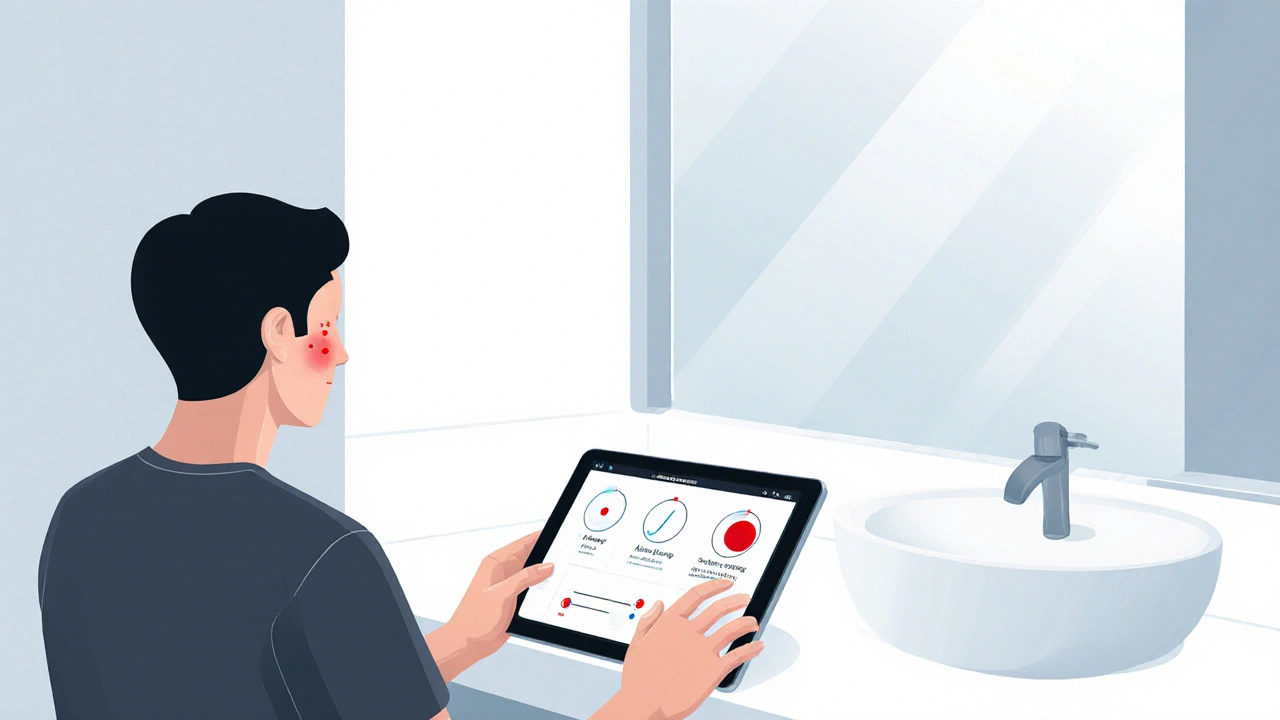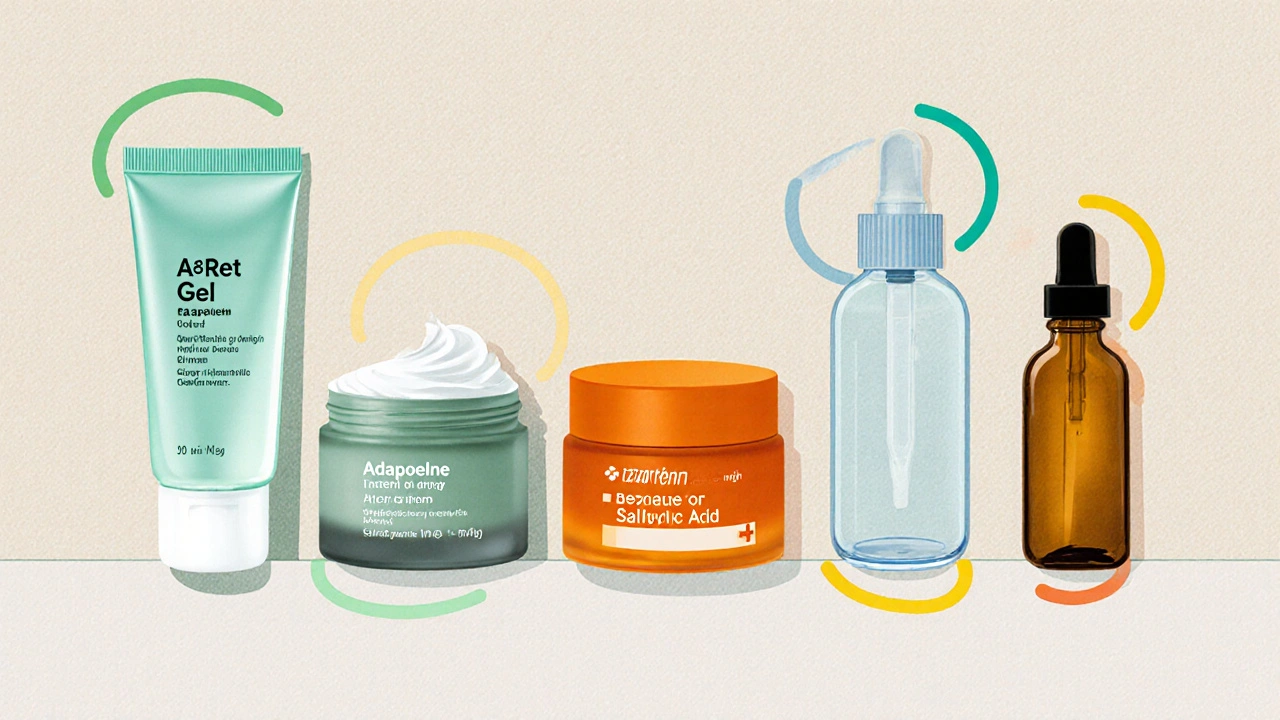
Retinoid & Acne Treatment Selector
Recommended Treatment
Why This Choice?
A‑Ret Gel (Tretinoin)
Prescription-strength tretinoin in a gentle gel base for acne and early signs of aging.
3 Irritation Level
Adapalene
Milder third-generation retinoid, available over-the-counter or by prescription.
2 Irritation Level
Tazarotene
Most potent prescription retinoid for stubborn acne but higher irritation.
4 Irritation Level
Benzoyl Peroxide
Antibacterial agent effective for acne but can bleach fabrics and dry skin.
3 Irritation Level
Salicylic Acid
Beta-hydroxy acid that exfoliates inside pores, gentle for daily use.
2 Irritation Level
Quick Takeaways
- A‑Ret Gel delivers prescription‑strength tretinoin in a gentle gel base, ideal for both acne and early signs of aging.
- Adapalene and tazarotene are the two other prescription retinoids; adapalene is milder, tazarotene is the most potent.
- Over‑the‑counter options like benzoyl peroxide and salicylic acid work differently and are less irritating for beginners.
- Pick based on skin tolerance, treatment goal (acne vs anti‑aging), and whether you need a prescription.
- Combine a retinoid with a soothing moisturizer or niacinamide to reduce dryness.
What is A‑Ret Gel?
A‑Ret Gel is a UK‑marketed formulation of tretinoin (all‑trans retinoic acid) in a light, non‑comedogenic gel. It comes in 0.025% and 0.05% strengths and is prescribed for moderate to severe acne as well as fine lines and hyperpigmentation. The gel base helps the active ingredient absorb quickly while feeling less greasy than classic cream versions.
How tretinoin Works
Tretinoin binds to nuclear retinoic‑acid receptors (RAR‑α, RAR‑β, RAR‑γ) and changes gene expression. The result is faster turnover of keratinocytes, unclogged pores, and increased collagen synthesis. In plain terms: it pushes dead skin cells out faster and tells the skin to build more structural protein.
Clinical studies from 2023‑2024 show a 30‑40% reduction in inflammatory lesion counts after 12 weeks of nightly use, while also improving skin texture by roughly 25% on objective scales.
Key Alternatives to Consider
When you’re weighing A‑Ret Gel against other options, it helps to know the mechanism, prescription status, and typical irritation level of each.
Adapalene
Adapalene is a third‑generation synthetic retinoid. It’s available over the counter in the U.S. (0.1%) and by prescription in the UK (0.1% and 0.3%). It’s less irritating than tretinoin because it selectively targets the retinoid‑binding protein 1 (RBP‑1), sparing some of the pathways that cause redness.
Tazarotene
Tazarotene is a pro‑drug converted in the skin to tazarotenic acid, a potent RAR‑γ agonist. It’s the strongest prescription retinoid available, usually in 0.05% and 0.1% creams. It’s praised for rapid clearance of stubborn comedonal acne but carries a higher risk of peeling and irritation.
Benzoyl Peroxide
Benzoyl peroxide (BPO) is an oxidizing agent that kills Propionibacterium acnes bacteria and reduces sebum plugging. It comes in 2.5%, 5%, and 10% gels or creams. BPO is OTC worldwide and works instantly, but it can bleach fabrics and cause dryness.
Salicylic Acid
Salicylic acid is a beta‑hydroxy acid (BHA) that exfoliates inside the pore lining. Concentrations of 0.5%-2% are common in washes, toners, and spot‑treatment gels. It’s gentle enough for daily use and targets blackheads, but it doesn’t have the same collagen‑building benefits as retinoids.

Side‑Effect Profile Comparison
| Product | Typical Strength | Prescription? | Primary Action | Irritation (1‑5) |
|---|---|---|---|---|
| A‑Ret Gel | 0.025%&0.05% | Yes | Retinoid - cell turnover + collagen | 3 |
| Adapalene | 0.1%&0.3% | Both OTC (0.1%) & Presc. | Retinoid - anti‑inflammatory | 2 |
| Tazarotene | 0.05%&0.1% | Yes | Retinoid - high‑potency | 4 |
| Benzoyl Peroxide | 2.5%-10% | No | Antibacterial + keratolytic | 3 |
| Salicylic Acid | 0.5%-2% | No | Exfoliant (BHA) | 2 |
Choosing the Right Option - Decision Guide
Use the following checklist to match your skin’s needs with the most suitable product.
- Treatment Goal: If you need both acne control and anti‑aging, tretinoin (A‑Ret Gel) or tazarotene are the only choices that boost collagen.
- Skin Sensitivity: For sensitive or rosacea‑prone skin, start with adapalene or a low‑strength BPO gel.
- Adapalene’s lower irritation score (2) makes it a safe entry point.
- Salicylic acid works well for non‑inflamed comedones and can be layered with a gentle retinoid.
- Prescription Availability: In the UK you’ll need a GP or dermatologist to get A‑Ret Gel or tazarotene. If you prefer a pharmacy‑only purchase, adapt to adapalene (0.1%) or OTC BPO.
- Speed of Results: Tazarotene often clears stubborn lesions in 4‑6 weeks, but the trade‑off is higher peeling. A‑Ret Gel delivers steady improvement over 8‑12 weeks with moderate irritation.
- Budget: OTC BPO and salicylic acid are the cheapest. Prescription retinoids can cost £20‑£40 per tube, but many NHS clinics cover them for severe acne.
Practical Tips for Using A‑Ret Gel and Alternatives
- Apply a pea‑sized amount to clean, dry skin in the evening. Nighttime use reduces phototoxic risk.
- Wait at least 20 minutes after washing before applying a retinoid; excess moisture dilutes the product.
- Follow with a moisturizer containing ceramides or niacinamide to calm the barrier.
- If you experience redness, start with every‑other‑night dosing for two weeks, then increase frequency.
- Never combine two strong retinoids (e.g., A‑Ret Gel + adapalene) on the same night; they’ll overwhelm the skin.
- Use broad‑spectrum SPF 30+ daily. Retinoids increase UV sensitivity.
Common Pitfalls & How to Avoid Them
Even experienced users slip up. Here are the usual mistakes and a quick fix.
- Skipping moisturizer: Leads to over‑dryness and premature discontinuation. Pair A‑Ret Gel with a lightweight, fragrance‑free moisturizer.
- Applying on wet skin: Water pulls the gel away, leaving patches. Pat skin dry before application.
- Using high‑strength BPO with a retinoid in the same routine: The combination can cause severe peeling. Alternate nights or use BPO in the morning and retinoid at night.
- Ignoring sun exposure: Without sunscreen, you’ll see hyperpigmentation flare‑ups. A broad‑spectrum SPF is non‑negotiable.
- Expecting instant results: Retinoids work on a 28‑day skin cycle. Patience pays off; expect noticeable change after 8 weeks.
Frequently Asked Questions
Can I use A‑Ret Gel if I’m pregnant?
No. Tretinoin is classified as pregnancy‑category C and has been linked to birth defects in animal studies. Women who are pregnant, planning pregnancy, or breastfeeding should avoid all retinoids and choose safer options like azelaic acid.
How long should I wait before switching from A‑Ret Gel to another retinoid?
Give your skin at least 4‑6 weeks to adjust. If irritation persists after that period, consult a dermatologist before moving to a stronger retinoid like tazarotene.
Is it safe to combine A‑Ret Gel with vitamin C serum?
Yes, but sequence matters. Apply vitamin C in the morning, let it absorb, then use A‑Ret Gel at night. This avoids pH conflicts and reduces the chance of irritation.
What’s the best way to store A‑Ret Gel?
Keep the tube tightly closed, away from direct sunlight and heat. A cool, dry bathroom cabinet works fine; avoid the shower shelf where steam can degrade the retinoid.
Can I use A‑Ret Gel on my body (back, chest) for acne?
Absolutely. Apply a thin layer to the affected area at night. Because body skin is thicker, you may tolerate a higher frequency, but start slowly to gauge irritation.
10 Comments
Write a comment
More Articles

Buy Cheap Generic Azithromycin Online - Safe Pharmacies & Price Guide
Learn how to safely buy cheap generic azithromycin online, spot legit pharmacies, compare prices, and follow dosing and shipping guidelines.


Mansi Mehra
October 4, 2025 AT 19:17The article presents the comparative data in a clear manner.